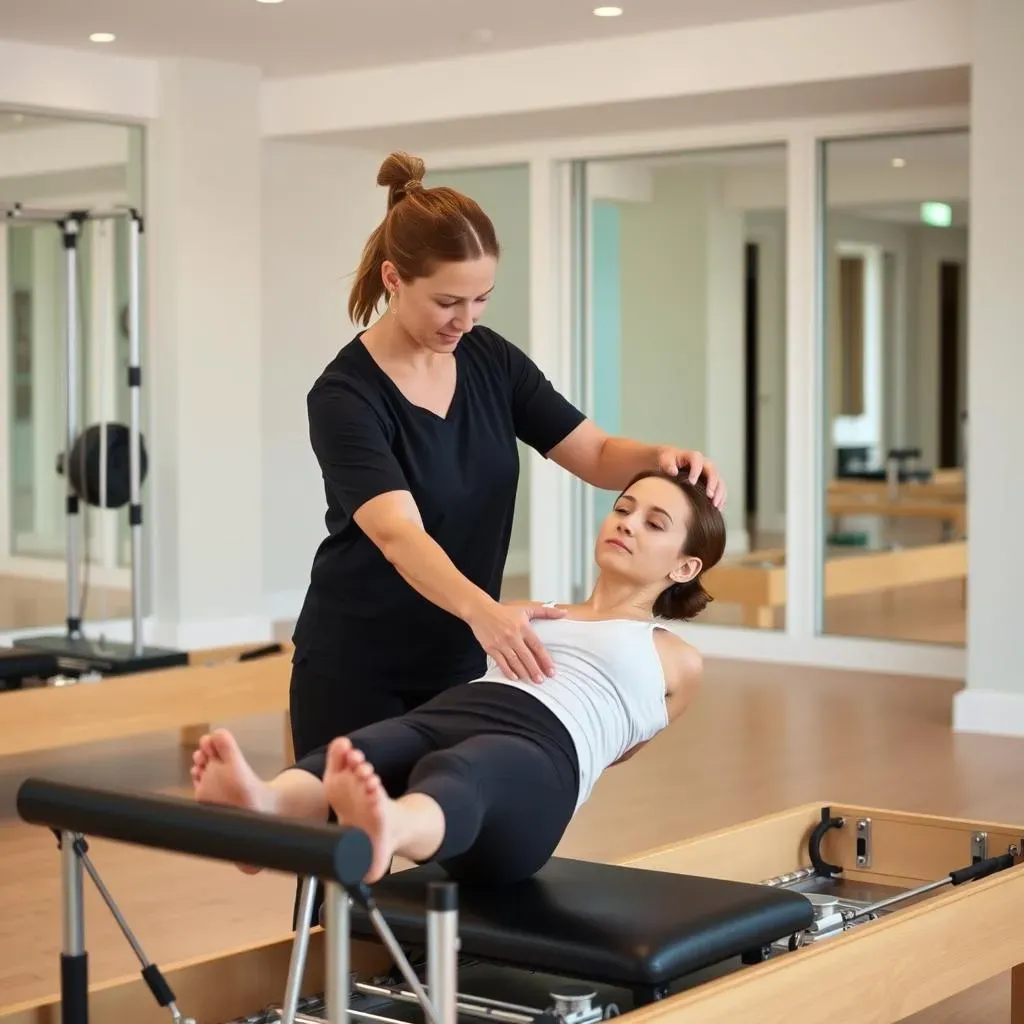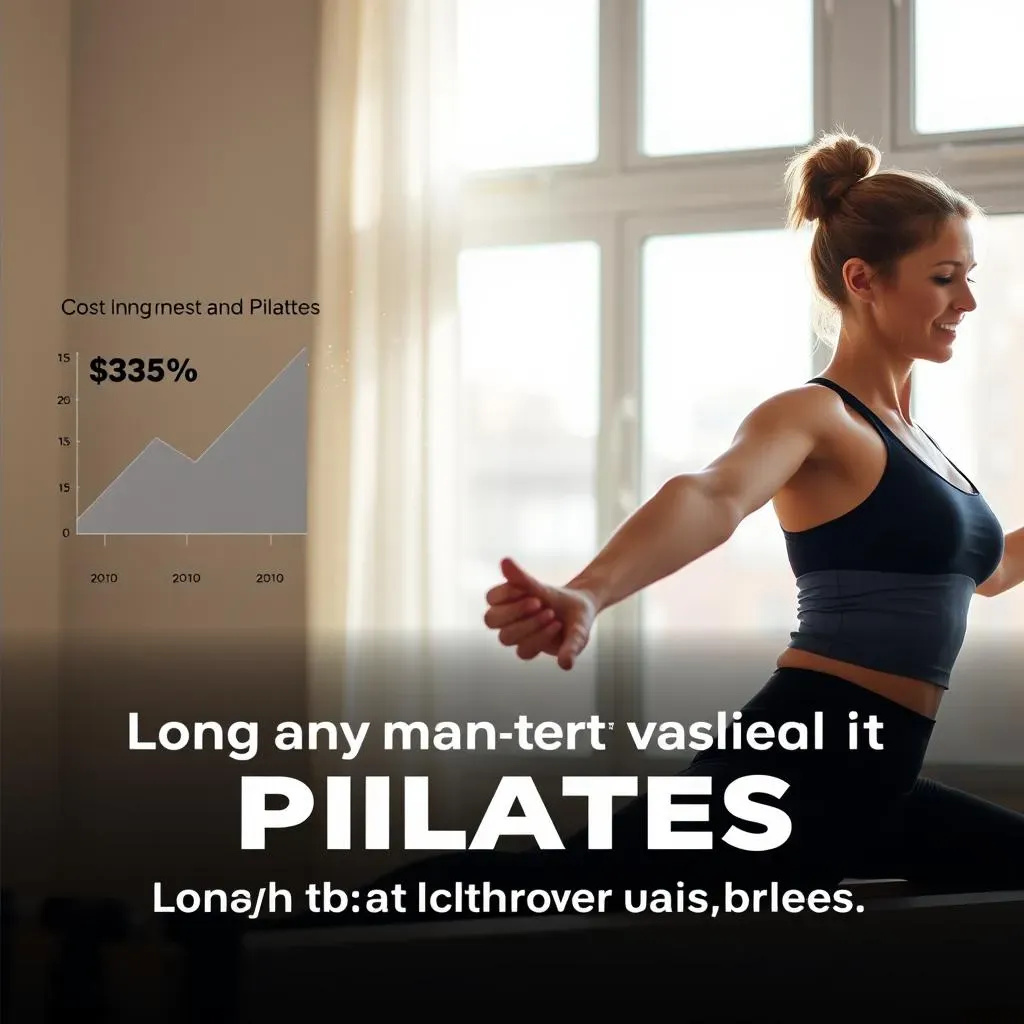Table of Contents
Thinking about getting serious with Pilates? Maybe you've tried a group class and felt a bit lost in the crowd, or perhaps you're dealing with an old injury that needs special attention. That's when the idea of one to one Pilates starts to sound pretty appealing. It's just you, an instructor, and a workout tailored exactly to your body. Sounds great, right?
Understanding Your One to One Pilates Cost

Understanding Your One to One Pilates Cost
More Than Just a Number
When you start looking into one to one Pilates cost, it's easy to fixate solely on the hourly rate. You see a number, maybe $75, maybe $150, and your brain immediately calculates how many sessions you can afford or how quickly that adds up. But truly understanding the one to one Pilates cost goes beyond that simple figure. It's about what that number buys you. It's the difference between a generic workout and something specifically designed for your body's quirks, its strengths, and yes, its grumpy bits that ache when the weather changes.
Think of it less like buying a gallon of milk and more like commissioning a custom piece of furniture. You're paying for expertise, undivided attention, and a program that evolves with you week to week. An instructor isn't just counting reps; they're watching your every micro-movement, correcting form you didn't even know was wrong, and ensuring you don't accidentally make that dodgy knee even dodgier. That level of focused guidance is the core of the investment.
Why Prices Aren't Uniform
So, why the wild variation in one to one Pilates cost from one studio to the next, or even within the same city? It's not just random. A few key things bump that price up or down. Location is a big one – a studio in downtown Manhattan is going to charge more than one in a quiet suburban town, pure and simple. Real estate isn't cheap, and that gets passed on.
Then there's the instructor's experience and certifications. Someone who's been teaching for two decades, trained under original Pilates elders, and holds advanced certifications will command a higher rate than a newly certified instructor. You're paying for that accumulated knowledge and skill. Studio overhead, equipment quality, and even the vibe of the place play a role. A fancy studio with top-of-the-line reformers and spa-like amenities costs more to run than a minimalist space.
- Instructor experience & certifications
- Studio location (urban vs. suburban, cost of living)
- Studio overhead (rent, equipment, insurance)
- Session length (typically 50-60 minutes)
- Package deals (buying multiple sessions often lowers the per-session cost)
What Drives the One to One Pilates Cost?

What Drives the One to One Pilates Cost?
let's talk turkey about what actually jacks up the one to one pilates cost. It’s not just some random number pulled out of a hat by studio owners on a whim. A huge chunk of it is the instructor themselves. Think about it: they've spent years, maybe even decades, training, getting certified (often multiple times with different schools), and logging thousands of hours working with bodies of all shapes, sizes, and levels of dysfunction. They see things you don't, feel things you can't, and know how to tweak an exercise so it hits *your* exact weak spot without aggravating that old injury. You're paying for that accumulated wisdom and the ability to get their undivided attention for an hour, focusing solely on *your* posture, *your* breath, *your* specific goals.
Beyond the human element, the studio itself plays a major role in the one to one pilates cost. Rent in a good location isn't free, neither is keeping the lights on, the equipment maintained (those reformers aren't cheap, trust me), and insurance paid. A well-equipped studio with clean facilities and state-of-the-art apparatus naturally has higher operating costs than a bare-bones space. You're paying for the environment, the tools available, and the convenience of the location. It's the whole package, not just the instructor standing in front of you.
Here are a few of the main culprits behind the price tag:
- Instructor's Credentials: More experience, specialized training, and advanced certifications equal higher rates.
- Studio Location: Prime real estate in expensive areas means steeper costs.
- Overhead: Rent, utilities, equipment purchase and maintenance, insurance – it all adds up.
- Equipment Quality: High-end reformers, Cadillacs, and Chairs cost serious money to buy and maintain.
- Session Duration: Standard is usually 50-60 minutes, but longer sessions will cost more.
Typical One to One Pilates Cost Ranges

Typical One to One Pilates Cost Ranges
Breaking Down the Numbers
let's get down to the nitty-gritty: the actual cash you're likely to fork over for one to one Pilates. There's no single, universal price tag, which I know is slightly annoying, but that's the reality. Generally speaking, you're looking at anywhere from $75 to upwards of $150 or even $200+ per hour-long session. This is a pretty wide spread, I'll grant you, and where you land on that spectrum depends heavily on where you live and who you're working with. A session in a swanky Beverly Hills studio with an instructor who's practically a Pilates guru will obviously cost significantly more than one in a smaller town with a newer teacher. It's like comparing the price of a coffee in a tiny cafe versus a five-star hotel lobby.
Most studios price sessions in 50 or 60-minute blocks. Some offer slightly shorter or longer times, but that hour mark is standard. They rarely sell just one session at a time unless it's an intro offer. Instead, they package them up, usually in blocks of 5, 10, or 20 sessions. Buying in bulk almost always knocks the per-session one to one pilates cost down a bit, which is their way of encouraging commitment and giving you a slight break if you're serious about sticking with it.
What Pushes the Price Up?
So, what makes one one to one pilates cost significantly higher than another? As we touched on before, location is a killer. Major metropolitan areas with high costs of living translate directly into higher studio rents and, subsequently, higher session prices. It's simple economics, unfortunately for your wallet. The instructor's reputation and experience are also massive factors. If your instructor has decades under their belt, specialized training in things like rehabilitation or pre/postnatal Pilates, or is highly sought after, they will command a premium rate. You're paying for that accumulated wisdom and proven track record.
The type of studio also plays a role. High-end studios with top-of-the-line equipment (think brand new Balanced Body or Gratz apparatus), luxurious changing rooms, and maybe even fancy filtered water and towels included will naturally have higher overheads than a more modest space. You're paying for the overall experience and amenities, not just the hour on the reformer. It's worth asking yourself what level of luxury you actually need versus what you're willing to pay for when considering the one to one pilates cost.
Think about these factors when comparing prices:
- Is the studio in a high-rent district?
- How many years has the instructor been teaching?
- Do they have specialized certifications (e.g., rehab, specific populations)?
- What is the quality and condition of the equipment?
- What amenities does the studio offer beyond the session itself?
Finding Value in the Range
Given the range of one to one pilates cost, how do you find something that fits your budget without sacrificing quality? First, don't be afraid to ask about introductory offers. Many studios provide a discounted first session or a small package deal for new clients. This lets you try out the instructor and the studio before committing to a larger expense. It's like a test drive before buying the car.
Consider instructors who might be excellent but are newer to the field or perhaps teach out of a slightly less fancy space. They might offer a lower one to one pilates cost while still providing excellent instruction. Certification matters, yes, but sometimes a passionate, well-trained newer instructor is a fantastic find. Also, inquire about off-peak hours; some studios offer slight discounts for sessions booked during less busy times of the day, like mid-morning on a weekday. Every little bit helps when you're looking at ongoing costs.
Is the One to One Pilates Cost Justified?

Is the One to One Pilates Cost Justified?
The Personalized Attention Factor
Alright, so you've seen the numbers, and maybe your eyebrows are still somewhere near your hairline. Is the one to one pilates cost *really* worth it? Let's be blunt: if you're just looking for a cheap way to sweat or something to do with your Tuesdays, probably not. Group classes exist for that, and they serve a purpose. But if you're seeking actual, tangible changes in your body, if you have specific issues you need to address, or if you just learn better with direct, constant feedback, then the justification starts to build.
Think about trying to fix a complex mechanical issue on your car by watching a general YouTube video versus hiring a mechanic who puts your car on the lift, listens to the engine, and diagnoses the *exact* problem. One-on-one Pilates is the mechanic. An experienced instructor isn't running you through a generic sequence; they are assessing your posture, watching how you move (or don't move) in every exercise, and constantly adjusting cues and spring settings to meet your body where it is *that day*. That level of tailored instruction is the primary driver of the one to one pilates cost and its potential value.
Specific Needs, Specific Solutions
Where the one to one pilates cost becomes particularly justifiable is when you have specific circumstances that make group settings less effective or even risky. Recovering from surgery? Dealing with chronic back pain? Pregnant or recently had a baby? These aren't scenarios where you want to be one of ten people in a class hoping the instructor catches your potentially harmful compensation pattern. You need eyes on you, all the time.
A private instructor can modify exercises extensively, ensuring you work within safe ranges of motion, build strength specifically where you're weak, and avoid movements that could aggravate your condition. They can also use a wider variety of equipment (Cadillac, Chair, Barrels) which might be necessary for certain rehabilitative exercises, equipment often less utilized in standard group reformer classes. This isn't just about getting a workout; it's about getting the *right* workout for a sensitive or recovering body. The potential to heal faster or prevent re-injury adds significant weight to the one to one pilates cost argument.
- Injury recovery or rehabilitation
- Chronic pain management (back, neck, joints)
- Pre and postnatal fitness
- Specific athletic performance goals
- Significant postural imbalances
- Beginners feeling intimidated by group classes
Long-Term Value and Efficiency
Consider the efficiency factor when weighing the one to one pilates cost. In a private session, you're not waiting for equipment, you're not trying to follow along in a crowded room, and the entire hour is focused solely on your progress. An experienced instructor can often help you understand fundamental Pilates principles and body mechanics much faster than in a group setting. This accelerated learning curve means you might see results sooner and build a stronger foundation.
Furthermore, by addressing specific weaknesses or imbalances early and correctly, you might prevent future injuries that could sideline you or require costly medical treatment. So, while the upfront one to one pilates cost per session is higher, the long-term benefit of a healthier, more functional body, and potentially avoiding physical therapy down the line, can sometimes offset that initial expense. It's an investment in your physical literacy and longevity. Ask yourself: What's the cost of *not* addressing that nagging issue?
Finding Value in One to One Pilates Cost

Finding Value in One to One Pilates Cost
Assessing Your Personal ROI
so you've seen the range of the one to one pilates cost, and maybe you're still doing mental gymnastics trying to justify it. The real trick to finding value isn't just comparing price tags; it's figuring out the return on *your* investment. What are your specific goals? Are you trying to get rid of that persistent back ache that makes sitting through a movie agony? Are you an athlete aiming for marginal gains that could make a big difference in your performance? Or are you just starting out and genuinely terrified of looking foolish in a group class?
If your goals are specific, health-driven, or require careful, individualized attention, the potential value of one to one Pilates skyrockets. You're not just paying for an hour; you're paying for an expert guide to help you navigate your body's unique landscape. They can spot compensation patterns you didn't know you had, unlock movement you thought was lost forever, and build strength precisely where you need it. The value lies in the efficiency and effectiveness of addressing *your* issues directly, rather than hoping a general class hits the mark.
Strategies to Manage the Price Tag
Let's be real, even if the value is there, the one to one pilates cost can feel like a punch to the gut of your bank account. But there are ways to make it sting a little less. First, always ask about introductory packages or single discounted trial sessions. Most studios want you to experience the difference before committing, so they offer a taste at a lower price. It's a smart way to shop around and find an instructor you click with.
Buying sessions in larger packages (5, 10, or 20 sessions) almost always reduces the per-session one to one pilates cost. Think of it as a bulk discount for your body. If you're serious about making progress, committing to a package saves money in the long run. Also, don't be afraid to inquire if the studio has different pricing tiers based on instructor experience. Sometimes working with a highly qualified but slightly less seasoned instructor can offer significant savings without sacrificing quality.
- Inquire about introductory offers or trial sessions.
- Ask about package deals (5, 10, or 20 sessions) for a lower per-session cost.
- See if the studio offers different rates based on instructor experience level.
- Ask if off-peak hours (e.g., mid-day weekdays) have discounted pricing.
- Consider semi-private sessions (2-3 people) if one-on-one is too steep, as they offer more attention than a large group class.
Viewing it as a Health Investment
Perhaps the most crucial shift in perspective when considering the one to one pilates cost is to stop seeing it purely as an expense and start viewing it as an investment in your long-term health and physical capability. Look, nobody *wants* to spend extra money, but compare that hourly rate to potential future costs: physical therapy sessions, chiropractor visits, pain medication, or even lost work time due to injury. A consistent, personalized Pilates practice can be a powerful preventative measure.
I had a client once, a desk jockey with chronic low back pain that made travel miserable. He balked at the initial one to one pilates cost. After three months of dedicated private sessions, focusing on core strength and hip mobility, he took a two-week hiking trip through Europe, pain-free. He later told me, "That trip? Priceless. The Pilates? Best money I ever spent." It's about building resilience and functionality that pays dividends in your daily life and keeps you doing the things you love without your body holding you back. That kind of freedom? Hard to put a price on it.
Making Your Decision on One to One Pilates Cost
So, we've broken down the factors contributing to the one to one pilates cost, looked at typical ranges, and considered the potential benefits. It's clear that private sessions come with a higher price tag than group classes. This cost reflects the individualized attention, the instructor's expertise applied directly to your body's mechanics, and the tailored program designed for your specific needs, especially if you're working around limitations or injuries. Whether this investment is "worth it" isn't a universal yes or no; it hinges entirely on your personal circumstances, budget, and fitness objectives. If you require focused rehabilitation, rapid progress, or simply prefer learning without the distractions of a group, the higher one to one pilates cost might be a practical expenditure. If budget is tight and you thrive in a communal setting without specific physical constraints, group classes might be sufficient. Ultimately, assess your needs honestly and perhaps even try an introductory private session to see if the tailored experience aligns with the potential cost.
